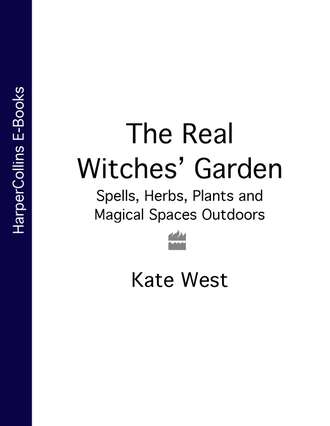
Полная версия
The Real Witches’ Garden: Spells, Herbs, Plants and Magical Spaces Outdoors

In the following chapters I shall look more closely at some of the ways of actually using your garden as a Sacred Space, a space for working magic and celebrating the Sabbats; a place of contemplation and meditation, to grow herbs and other useful plants; a place dedicated to your favourite or personal deities; even a place where you can introduce your children to a love of nature. But you also need to take into account the non-Craft activities you enjoy. If you like sunbathing, then you will need an unshaded space to stretch out in. If you want to hold summer barbecues, then a place where you will not set fire to, or scorch, your plants is essential. If, like me, the winter wind howls across the landscape, then you will need to retain a windbreak hedge. To help you to plan the potential uses of your garden, write a month by month list of the sorts of things you want to do outside, the difficulties they pose and your ideas for solutions. You may find you come up with some difficulties to which you cannot think of an answer. Don’t despair, keep your list for a few months while you look around, watch TV gardening programmes and read books; it can be surprising how much inspiration the Goddess will provide to the patient.
HOW MUCH SPACE DO YOU HAVE?

If you have a reasonable-sized garden, that is well and good, but for those of you with little or no outdoors of your own, try to consider the following: Do you have room to securely fix one or more window boxes? Can you use indoor windowsills? Can you place a table or perhaps a bookcase in front of a window and use that space? If you have a light room, could you perhaps denote a corner or patch to be an indoor garden area? Perhaps you could even transform a gloomy corner. When it comes to the garden as a part of your Craft you do not need much – a reasonable-sized tub on a waterproof dish, or a couple of pots on your windowsill can easily be enough. Chapter 9 focuses on the non-existent, or almost non-existent, garden.
WHAT IS IT CURRENTLY BEING USED FOR?

One of the problems of a garden is that it quickly becomes a multifunctional area, often to the detriment of its garden aspect. Parked cars, secured bikes, children’s toys, washing lines, dustbins and so on all take from your natural space. Not that these things aren’t compatible with growing things and celebrating the Craft, but you may need to give some thought to maximizing your usable space. This could be as simple, if not always easy, as encouraging others to put their things away. On the other hand you might like to think about finding ways of storing things more sympathetically; hooks in a garage, or a storage ‘bin’ into which odds and ends can be packed. One of my somewhat unusual solutions lies in having a large second-hand filing cabinet in the garage. This stores, in a vertical rather than horizontal space, a wide miscellany of outdoor toys, gardening bits and things we have no use for, but are reluctant to get rid of yet! Some of the things you keep outside of the home cannot be put away, dustbins and coalbunkers for example, but they needn’t look quite so ugly. Consider planting climbers on, or in pots around, such items.
WHO ELSE USES IT?

Most of us have to share our garden in some way or another; perhaps with family members who may not practise the Craft, with children who want a play area or with pets who see it as an area of convenience! Not only that, but few of us have the luxury of complete privacy, as so many of today’s gardens are overlooked, or what takes place in them can be overheard. Whilst you can always attempt to place plants in such a way as to minimize this, you don’t want to end up with no natural light ever reaching your garden, or for that matter the windows of your home! Also give some thought to the safety aspect.
For example, ponds and toddlers, yours or visiting, don’t mix. But if you carefully fill your pond with large stones, you can still grow your water plants and keep the young ones safe. Steps, concrete or stone corners and other sharp edges are likewise a hazard to the very young, the very old and the infirm. If these features are already present, consider putting up guard rails, or other obvious identifiers. If you need them as part of your plan, think about rounded edges, or using wood instead.
HOW WILL YOUR ENVIRONMENT AND
CLIMATE AFFECT YOUR PLANS?

Soil type, weather, rainfall, drainage, pollution and so on should also be taken into account. The problems they pose are not insoluble, but give them some thought or you could end up expending a lot of energy counteracting a series of inherent conditions.
The type of soil you have will influence the kinds of plants which will grow in it. Of course you could strip off your topsoil and have it replaced, but that is somewhat extreme and not cheap! Dig a small hole about 8 inches deep and have a good look at what you’ve got. Too much clay and it will be heavy, hard to drain and may set like concrete in the Summer. Too much sand and it will drain freely and dry out quickly in hot weather. Both of these problems can be helped by digging in some organic matter. A friend of mine recently had several tons of ‘mature’ pig manure delivered free, by a farmer only too glad to get rid of it, but this is a bit extreme. Create your own quick compost by sweeping up Autumn leaves and storing them in bin liners until they get smelly. Dig this through and it will help no end. It is also a good idea to test the pH balance of the soil; you can get kits from your garden centre. If your soil is particularly acid or alkaline (chalky), try to choose plants which like these conditions, and grow others either in pots or in ‘wells’ which you have lined generously with potting compost.
Give some thought to local rainfall and the water table. If your 8-inch hole rapidly filled up with water, you’re probably in a damp zone! If in doubt, your local radio weather forecaster may be able to answer a patient enquiry, and you could ask them about hours of sunshine and average temperatures at the same time; alternatively, have a look on the Internet. Too little water is relatively easy to fix, as you can collect rainwater in a barrel and water regularly, but a damp climate will never suit plants which prefer to grow in the desert!
Spend a day tracking the amount of direct light falling onto your garden (it’s easier to do when the Sun is shining). This will tell you where best to plant sun-, or shade-, loving plants.
Take a look at the kinds of industry in your area, for about 5 miles around! If there’s anything that seems likely to produce pollution, seek out tolerant plants. Take a look at roadside growing areas around you, with a good field guide handy, for some really good clues. Also, talk to your neighbours or take a quick look over their fences, briefly to avoid embarrassment, and see what’s doing well there, to give you some ideas.
HOW WILL YOU AFFECT LOCAL WILDLIFE?

Please give a thought to local flora and fauna. Check out holes and tracks to see whether they are in use. A light dusting of cornflour will easily show up prints. Be considerate with weedkillers, insecticides, fertilizers, hedge trimmers and when digging up stuff. If you have huge amounts of weeds, or a thicket of brambles, they’re probably doing a good job of feeding birds, growing caterpillars and so on. Don’t remove these sanctuaries all in one go, plant a refuge in an inconspicuous corner, or clear a portion at a time. Rampant growth is usually good for creatures which benefit the garden, so if you banish them you may acquire all kinds of interesting problems which you could have avoided. Try to find a corner for nettles, brambles and a small heap of decaying wood, as this will attract beneficial insects.

To take your Craft into your garden, whatever it’s like, it is first important to assess what you have got and what you need from it. Being a Witch is being a part of reality so you have to take into account the physical constraints of your location, family and life, not to mention the amount of time and effort you can really devote to it. Having said that, with a little ingenuity, you can make a big difference with just a little thought and effort.
One of the ways of assessing your patch of earth is to look at those around you – if your neighbourhood is knee-deep in lavender then there’s a good chance it will grow in your garden too! Established plants in your garden and those of your neighbours will give you a good indication of soil and climate type.
If you move into a new house, and if you can possibly bear to, wait one year to see what is already in the garden. Or maybe you could ask the previous occupiers if they have any photos, as proud gardeners often do.

The following chapters contain ideas for different ways of designing and using your garden to enhance your Craft. It is not intended that you use all of these ideas, indeed you would need a vast area to do so! Rather take those which most appeal to you and will fit your garden and your life style. Feel free to adapt them, or to use them as a starting point from which to create something personal.

THREE THE GARDEN AS YOUR SACRED SPACE

As I have often said, Witches do not have special buildings or even rooms set aside as places of Ritual and Magic. We create our Sacred Space wherever and whenever we need it. To do this we need a clear area, large enough for the number of people who are to take part. We then invoke the elements of Air, Fire, Water and Earth and invite the Goddess and the God. When working magic, rather than simply celebrating the festivals, we also cast a Circle, which contains the energies raised until it is time to release them. At the end of our working, we then remove the Circle, banish the elements and thank the Goddess and God. It is also usual to have some kind of Altar within the Circle, onto which we place representations of the elements, the Goddess and the God, and any working tools and equipment we may need during our working. This is also cleared away at the end. However, as the Craft is a nature-based belief system, it is always nice to be able to practise at least some of it, weather permitting, outside alongside nature and the elements.
Practising the Craft outside has certain differences; obviously you do not need to take representations of the elements outside, they are there in the air, sun- and moonlight, rain and soil. The Goddess and the God are also present as they are the life force which causes everything to grow, and are seen in the cycles of life, death and rebirth which are all around. If you intend to use your garden, or a part of it, as a Sacred Space, you can therefore install and care for its components as a part of your usual gardening life. There are many levels of doing this from a complete garden makeover to the more practical placement of one or two plants and objects which are less obtrusive. Here I shall look at a few ideas for a complete makeover, but will focus more on the simpler approach.
PLANNING YOUR SACRED SPACE

In an ideal world you could have a lawn shaped as the triple moon, or as a circle with the pentagram picked out in flat stones or bricks. I even know of one garden where the owner has created a pentacle with small paving stones and has planted different plants and herbs in each of the different sections. You could also perhaps place elemental markers at the appropriate points, either plants or actual physical representations such as wind chimes in the east for Air, an outdoor flame or torch for Fire, a pond or fountain for Water in the west and a large stone in the north for Earth. This stone could also double as your Altar, or you could have a second Altar stone in the centre. If the area is not overhung with trees, or otherwise likely to suffer from fire damage, you could dig a permanent fire pit in the centre, or even have a permanent cauldron. If you wish, and can find reasonable ones, you could also place a statue of the Goddess and the God in the north of your Circle. Traditionally, the Witches’ circle is 9 feet (2.75 m) across, but if you will be working on your own it can be smaller. Around your circle you could place plants which act as screens for privacy, as well as those which are related to the elements, the Goddesses and Gods of your choice, or even those which are associated with the Wheel of the Year. Chapter 10 gives lists of plant associations.
However, most of us do not have the luxury of being able to not only start from scratch but also of being able to let our Craft dominate the use of even a part of the garden. In this case you may like to take ideas from the above and incorporate them into your existing space or use some of the following suggestions.
Firstly, you need to determine where the four quarters lie. This can be achieved precisely by using a compass, or more simply by noting where the Sun rises (in the east) and sets (west) and working from there. You do not have to be precise. In each of the quarters place a single plant in the colour of that element; yellow in the east, red in the south, blue in the west and green in the north. Of course they may well not be in flower all year round but nevertheless they will be present as reminders. If you really do not have the room to make these permanent fixtures, keep your plants in pots and put them in place only when needed. Alternatively, you could have a plant which rustles in the east, a sundial in the south, a birdbath in the west and a special stone or rock in the north.
Try to incorporate a permanent Altar, although it need not be too obvious. Whilst you do not need a large area onto which you can put a great many things, at the very least it is a good idea to have somewhere safe to place a candle, usually in a jar to protect it from the wind. This could be a small flat stone or rock. The Altar can be placed in a number of parts of the Circle, for example, the east as the point of beginning, or the centre, or the north, which is known as the place of power. Generally speaking, a rock in the centre of your area is likely to be an inconvenience, as it may well get in the way of any outdoor activities. If it is in the centre of a lawn it will cause complications when mowing, and it will almost certainly give rise to comments from friends and neighbours. So this leaves you with the choice of north or east. If you really can’t leave something permanently then try to choose something you can easily and safely move from one place to another. A small outdoor table or even a stool can make a good substitute for a rock or stone, and is much easier to move around!
Privacy is a much harder problem to overcome. If you start erecting screens in your garden, you are more likely to increase the interest of your neighbours than decrease it. If you try to grow plants which will effectively obstruct their view of you, these may well give rise to complaints about the amount of light their garden receives, not to mention cast your area into the shade. And whilst it would be nice to think that it’s none of their business what you get up to in your garden, you will still have to live alongside these people. A little eccentricity may well be tolerated, but a full-blown Witches’ gathering is almost certainly going to be too much! In reality, the only solution is to temper what you do and how you do it. So, if you are overlooked, you may have to give up ideas of working skyclad or even robed, and you may also have to consider whether Circle dancing, chanting and drumming are going to be acceptable. Of course, if you work on your own you probably don’t do all these things anyway, as solitary Craft does not require you to wave your arms or speak aloud, but do give some thought as to how you may appear to someone looking out of their window on a moonlit night. For the Witch on their own, simple screening, such as encouraging a climber or two in the direct line of sight, is often enough to give you the peace you need.
Once you have determined where and how to mark your Sacred Space you need to bless, dedicate and consecrate it. This is done in several steps. Firstly, before you start any work on the area, ask the blessing of the Goddess and the God. Secondly, as you work, dedicate your efforts to the Goddess and the God. Thirdly, perform a Ritual to consecrate the space. The best time of year to do this would be Spring, when nature is ready to put fresh effort into growth. But there is no reason why you should not commence at other seasons and continue the work thereafter. Chapter 8 gives advice on the seasonality of sowing, planting and reaping.
SEEKING THE BLESSING OF THE GODDESS AND THE GOD
Work for this should commence prior to the New Moon as you will need to collect about a pint of rainwater. If your area is very arid then try to collect water from a stream or river and bring it back to your garden. If this really is not possible then you will need to take tap water and place it in a sealed jar in the light of the Full Moon for three nights and then wait for the next New Moon to continue. You will also need to make an asperger. This is done by taking a few thin twigs about 6 to 8 inches (15 to 20 cm) in length and tying them at one end to make a sort of ‘mini-broom’. If you can, gather these twigs from fallen wood found in your own garden, otherwise collect them from a nearby wooded area.

At the New Moon, the time of fresh starts and new beginnings, take your water, asperger and some salt outside into the garden. In the centre of your future Sacred Space, kneel and call, using visualization, each of the elements coming from their appropriate directions. Next, visualize the Goddess and the God and invite them to be with you. When you are sure all is in place, take a pinch of salt and add it to the water, saying, in your head:
‘I call upon the elements and upon the Old Gods to consecrate and bless this water. May it drive out all impurities and may it bring the love of the Goddess and the God to this place. Blessed Be.’
Now with your asperger, sprinkle a little of the water around the outside edge of your Circle. Be sure to start at the north-east and to proceed deosil (clockwise) around the Circle until you have overlapped at the north-east. Return to the centre, once again visualize the Goddess and the God, and say:
‘I call upon the Goddess and the God of life and all things living, to grant that this may be a place of growth, for all the life that shall use it. May it ever be a place of joy, love and magic. May it aid me to honour the Gods and the Craft. Blessed Be.’
Remain a while and visualize the area as you hope it to be, and visualize yourself using it. When you are ready, thank the elements and the Goddess and the God. Where there is more than one of you taking part, everyone should perform the same actions, one after the other.

DEDICATING YOUR SACRED SPACE
This is not a Ritual but rather an ongoing process which takes place whilst you do the work on your Sacred Space.

Over the next two weeks, and indeed any time you need to tend your area, always start by visualizing the Goddess and the God. Ask their blessing and state that you are dedicating this work to them. An effective way of doing this is to gather any gardening tools together into the centre of your space and then to close your eyes for a moment.
Visualize the Goddess and the God and say:
‘I call upon the Old Gods to witness this work which I do in their honour. May they guide and support me in this as in all things. Blessed Be.’
Then continue your work. If you are simply making a few changes or additions to your existing garden then do not forget to tend other plants; dead-heading flowers past their best, removing dead wood or weeding between existing plants. For most people, the two weeks between the New and Full Moons will be sufficient for them to carry out the work in the garden. But if your plans are more complex, you are planting many new plants or your workload is heavier, then you may need to continue to work through the next lunar period, before consecrating your Sacred Space at a subsequent Full Moon. It is more important to be thorough than to hurry, as you are creating a permanent Sacred Space, and besides, nature, like the Goddess, takes her own time.

CONSECRATING YOUR SACRED SPACE
The ritual of Consecration could take place at the next Full Moon, but it is important that any plants have had time to establish themselves as it can be very disheartening to find that perhaps one or two specimens were not as good as you hoped and wither or die just after your Ritual! So if you are not sure they have had time to settle in it might be better to wait until the following Full Moon.

Once all is in place and you are happy that any plants are established, it is time to hold your Ritual. You will need: A small glass containing some wine or fruit juice.
Start at the east and say, either quietly or in your head:
‘I call upon the element of Air. Mighty winds and gentle breezes be present here, each in its turn and in its season. Watch over this space, those that live, work and play in it, and all that takes place in it. May the Air of thought and inspiration be ever strong here. Blessed Be.’







